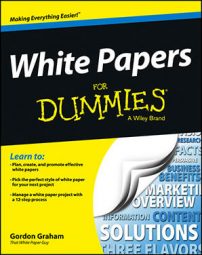B2B marketing teams generate all sorts of content to get the word out about their products or services, including white papers, blog posts, brochures, case studies, and e-books. Not everyone knows what sets each type apart from all the rest or when to choose one over another.
White papers vs. blog posts
Most people can tell the difference between a white paper and a blog post. For starters, a white paper is much longer. Beyond that, a good white paper is based on established facts and logical arguments, like a well-researched article in an industry journal. But a blog post can be sheer opinion or even a rant, like a letter to the editor.
After you write a white paper, you can easily create blog posts from it. In fact, a good white paper contains enough ideas to fuel several posts. Here’s the best way to use both together:
Publish an effective white paper.
Extract one key idea to blog about.
At the end of the blog, point to the landing page for the full white paper.
Repeat Steps 2 and 3 to cover all the key ideas in the white paper.
Using the SEO power of your blog helps build visibility and downloads for your white paper. However, don’t expect an instant rush of web traffic. Business buyers take a good white paper far more seriously than a blog post.
After you publish a white paper as a numbered list, make sure to blog about it. Your blog can present the bare list of numbered points and direct readers who want more details to the full white paper. Your white paper can present more detail, more evidence, and more logical arguments than the blog post.
White papers vs. brochures
White papers and brochures are almost complete opposites. Brochures are sales documents intended to create interest and desire, often by pushing emotional buttons, such as fear, greed, envy, or vanity. Brochures are generally colorful, flashy, and filled with promises, using copywriting and advertising techniques.
White papers, on the other hand, are persuasive essays about a certain B2B product, service, technology, methodology, or new solution to an old problem. White papers persuade through irrefutable facts, ironclad logic, impeccable statistics, and quotes from industry opinion makers. They’re generally less flashy and more factual. A white paper should be more dignified, substantial, and informative than a brochure, using plain English and the occasional rhetorical device.
Some companies simply reformat an existing brochure and call the results a white paper. Doing so is a waste of effort that irritates most readers when they discover you’ve given them nothing but a sales pitch. Take the time to write a proper white paper, and you’ll be rewarded with more leads, better word of mouth, and increased sales.
White papers vs. case studies
Case studies are extended testimonials on how a product or service helped someone in the real world. They’re typically 750 to 1,200 words long, written in a journalistic style with many quotes from the customer. Case studies tend to be used later in the sales cycle to reassure a prospect that other buyers just like them benefited from the same offering and are prepared to endorse the vendor.
White papers, on the other hand, are persuasive essays, generally 3,000 words or more, written in a somewhat academic style, with no direct quotes from the vendor. A white paper may use the problem/solution structure but rarely before/after. White papers tend to be used earlier in the sales cycle to help prospects visualize a possible solution to a nagging problem.
You can include a brief case study inside a white paper, either as a sidebar, a proof point in the text, or a pull quote. You’ll likely need to condense the case study and include only the bare outline of the story, such as the bottom-line results.
White papers vs. e-books
This doesn’t mean an e-Pub version of the latest vampire novel for tweens. I’m thinking only of the e-books published by B2B companies as part of their marketing efforts. And these two marketing documents — an e-book and a white paper — are often the most difficult of all to tell apart.
With no clear standards or conventions established yet for e-books, people call just about anything an e-book. An e-book can be anywhere from 10 to 100 pages long and packaged as a PDF, slide deck, or some lesser-known format.
An e-book can have a lot of color and graphics, or not much at all. Fans of e-books call them “the hip and stylish younger sister to the nerdy white paper,” while those of the opposite opinion say things like, “put some lipstick on a white paper and you’ve got an e-book.”

